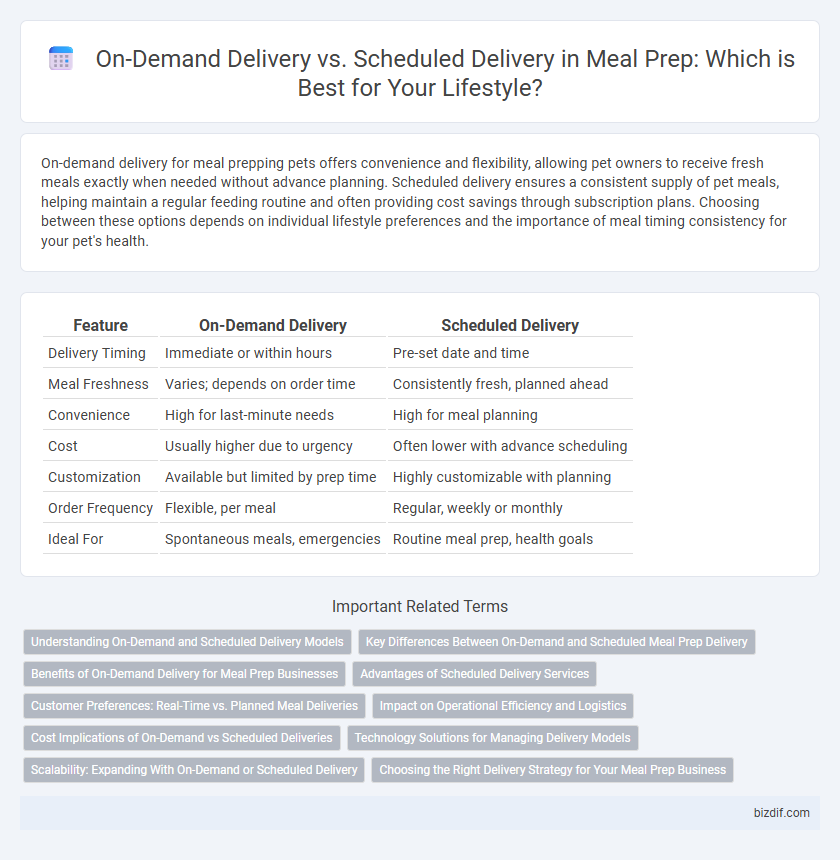On-demand delivery for meal prepping pets offers convenience and flexibility, allowing pet owners to receive fresh meals exactly when needed without advance planning. Scheduled delivery ensures a consistent supply of pet meals, helping maintain a regular feeding routine and often providing cost savings through subscription plans. Choosing between these options depends on individual lifestyle preferences and the importance of meal timing consistency for your pet's health.
Table of Comparison
| Feature | On-Demand Delivery | Scheduled Delivery |
|---|---|---|
| Delivery Timing | Immediate or within hours | Pre-set date and time |
| Meal Freshness | Varies; depends on order time | Consistently fresh, planned ahead |
| Convenience | High for last-minute needs | High for meal planning |
| Cost | Usually higher due to urgency | Often lower with advance scheduling |
| Customization | Available but limited by prep time | Highly customizable with planning |
| Order Frequency | Flexible, per meal | Regular, weekly or monthly |
| Ideal For | Spontaneous meals, emergencies | Routine meal prep, health goals |
Understanding On-Demand and Scheduled Delivery Models
On-demand delivery provides customers with immediate meal service, leveraging real-time inventory and efficient logistics to meet urgent needs. Scheduled delivery allows users to plan meals ahead, ensuring consistent meal availability and optimized route planning for cost-effectiveness. Both models rely on advanced order management systems and data analytics to balance convenience and operational efficiency in meal prepping services.
Key Differences Between On-Demand and Scheduled Meal Prep Delivery
On-demand meal prep delivery offers immediate access to fresh meals tailored to spontaneous needs, providing flexibility without prior planning. Scheduled meal prep delivery operates on a fixed timetable, ensuring consistent, pre-planned meal availability that supports routine dietary habits. Key differences include delivery timing, customization options, and convenience, with on-demand prioritizing speed and adaptability, while scheduled focuses on reliability and meal consistency.
Benefits of On-Demand Delivery for Meal Prep Businesses
On-demand delivery enhances meal prep businesses by providing swift, flexible order fulfillment that meets customer expectations for convenience and freshness. Real-time delivery capabilities reduce food spoilage and inventory waste, increasing operational efficiency. This service model also expands market reach by catering to spontaneous orders and last-minute meal needs.
Advantages of Scheduled Delivery Services
Scheduled delivery services for meal prepping offer consistent timing, ensuring meals arrive fresh and ready exactly when needed, which enhances meal planning efficiency and reduces food waste. Customers can tailor delivery days to their weekly routines, allowing better coordination with work and personal commitments. This predictability also facilitates bulk ordering and cost savings, making it an economical choice for regular meal preparation.
Customer Preferences: Real-Time vs. Planned Meal Deliveries
Customer preferences in meal prepping often diverge between on-demand delivery and scheduled delivery, with real-time meal deliveries favored for their convenience and spontaneity. Scheduled delivery appeals to those who prioritize planning and nutritional consistency, ensuring meals align with specific dietary goals and timing. Data shows that 65% of users prefer scheduled delivery for weekly meal planning, while 35% opt for on-demand services to accommodate unpredictable lifestyles.
Impact on Operational Efficiency and Logistics
On-demand delivery accelerates meal prep turnover by enabling real-time order processing, reducing inventory holding times and minimizing food waste. Scheduled delivery allows for batch processing and optimized route planning, enhancing fuel efficiency and predictable staff allocation. Balancing these models improves operational efficiency by aligning logistics with customer demand patterns and resource availability.
Cost Implications of On-Demand vs Scheduled Deliveries
On-demand meal delivery often incurs higher costs due to expedited shipping fees and increased labor expenses, leading to premium pricing for consumers. Scheduled deliveries optimize route planning and batch orders, resulting in reduced operational costs and more affordable meal options. Businesses benefit from predictable demand patterns with scheduled deliveries, enabling better inventory management and lower overhead expenses.
Technology Solutions for Managing Delivery Models
Technology solutions for managing on-demand and scheduled meal prep delivery models utilize advanced algorithms and real-time data analytics to optimize route planning and reduce delivery times. Integrated platforms enable seamless customer interaction, allowing users to choose preferred delivery windows or request immediate dispatch, enhancing user experience and operational efficiency. AI-driven inventory management and predictive analytics ensure accurate order fulfillment and minimize food waste across both delivery methods.
Scalability: Expanding With On-Demand or Scheduled Delivery
On-demand delivery offers scalable flexibility by enabling real-time order fulfillment, which supports fluctuating customer demands and rapid market expansion. Scheduled delivery streamlines operations through predictable logistics, optimizing workforce allocation and inventory management for sustained growth. Combining both methods can enhance scalability by balancing immediate responsiveness with efficient planning in meal prepping businesses.
Choosing the Right Delivery Strategy for Your Meal Prep Business
Choosing the right delivery strategy for your meal prep business impacts customer satisfaction and operational efficiency. On-demand delivery offers flexibility and quick service, ideal for last-minute orders, while scheduled delivery enables better route planning and consistent customer expectations. Evaluating order volume, customer preferences, and delivery costs ensures an optimized approach that supports growth and reliability.
On-Demand Delivery vs Scheduled Delivery Infographic

 bizdif.com
bizdif.com